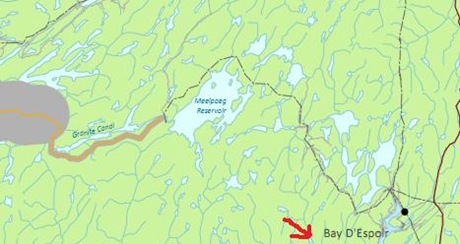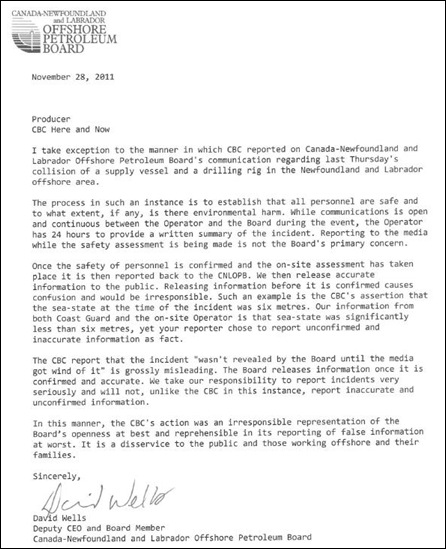The provincial government waited until late Friday afternoon to issue a bulletin that Emera had registered the Nova Scotia interconnection with the environment department for review.
That’s weird because Friday is usually when you release news you want to bury. Friday is normally a crap news day since people don’t pay attention to the Friday nights news.
If you can’t kill the story, you can at least be assured that after the weekend, the story will be significantly weaker than if it hit on Monday and had a whole week to build steam in the glare of cameras and media inquiry.
So if you were going to close a couple of fish plants, you’d do it on Friday. Premier Kathy Dunderdale could still look severely stressed in the media clips – we are talking edge of a stroke stress here – but still the story would likely have less fuss than if it had been released on its own on Monday, 8:00 AM.
But the electricity line to Nova Scotia – a supposedly huge part of the Muskrat Falls development - is not the news you’d like to bury.
Well, at least you wouldn’t think so, especially since by the time it hit the wires, the fish plant story was already owning the front end of the news cycle.
So if releasing it on Friday afternoon is odd, then the actual wording of the announcement is odder still:
Maritime Transmission Link (Reg. 1618)
Proponent: ENL Maritime Link Inc.The proponent, ENL Maritime Link Inc., a wholly-owned subsidiary of Emera Newfoundland and Labrador Holdings Inc., is proposing to design, develop and operate the Maritime Link Transmission Project between the Island of Newfoundland and Cape Breton, Nova Scotia. The transmission link is a 500 MW, +/-200 to 250 kV high voltage transmission system that includes the following elements and associated infrastructure: transmission corridors, subsea cables, shore grounding facilities, two converter stations and adjoining substations, two transition compounds and other potential infrastructure as required. The three main geographical components of the project are:
- Newfoundland component - In southwestern Newfoundland, a new transmission line between Cape Ray and Bottom Brook along an existing transmission corridor and Bottom Brook to Granite Canal in a combination of existing and new corridors.
- Cabot Strait component – Crossing the Cabot Strait, two subsea cables spanning approximately 180 kilometres from Point Aconi (or Lingan), Nova Scotia to Cape Ray, Newfoundland (exact location to be determined).
- Nova Scotia component - In Cape Breton, Nova Scotia, a new transmission line (approximately 50 kilometres in length) parallel to the existing transmission corridor centerline between Point Aconi (or Lingan) and Woodbine.
Project construction is scheduled to begin in 2014 and first power planned for delivery in late 2016 or early 2017.
The undertaking was registered on December 1, 2011; the deadline for public comments is January 6, 2012; and the minister’s decision is due by January 14, 2012.
Notice right off the bat:
- No Nalcor. The thing is registered by a wholly-owned subsidiary of Emera.
- No Muskrat Falls. No Lower Churchill at all, in fact.
- No room. There is a single 500 megawatt line. That won’t much – if any – capacity for exporting power beyond Nova Scotia.
- Construction isn’t tied to Muskrat at all.
- The construction dates anticipate first power received in 2016. That doesn’t match up with likely Muskrat timelines given the continued delays in that project.
Go to the registration document and a few more curious things show up.
Like, for example, the Maritime line on the island of Newfoundland isn’t going to run out towards Clarenville as the Nalcor documents suggested.
It’s going to start at Granite Canal, an existing Nalcor generating site on the south-western part of the island. It’s not far from the big hydro plant at Bay d’Espoir. And it’s close enough to the former Abitibi generating facilities that Nalcor got as a bonus courtesy of the 2008 expropriation.
Here’s a section of one of the maps provided in the registration documents:
And remember that curious absence of a reference to the Lower Churchill in the notice? Well, there are a few mentions of the Lower Churchill in the registration documents. One of them notes that the Maritime link will allow surplus LC power to flow to Nova Scotia but…
The Maritime Link will have no direct connection to the Labrador-Island Transmission Link, which is a project being developed by Nalcor Energy, as the proponent, along with the Lower Churchill Hydroelectric Generation Project. The Maritime Link has a separate utility due to the fact the Project will serve as a complete and independent connection between Nova Scotia and the existing electrical system. Project Registration on the Island of Newfoundland, will operate independent of the Labrador-Island Transmission Link, and is the only transmission facility which will connect the two provincial grids. [Emphasis added]
Yes, friends, it is separate and independent.
And that’s interesting in light of the announcement last week of industrial benefit opportunities for Nova Scotians on a project - Muskrat Falls – in which they have no direct involvement apparently.
Anyway, the details of the Maritime link suggest that Nalcor intends to keep all the Muskrat power in the province, if it gets built. They’ll meet their commitments to Nova Scotia using the huge amount of surplus power in the central Newfoundland hydro-electric system.
That stuff is all bought and paid for or seized so there’s basically very little cost associated with it. That would explain how Nalcor would plan to meet its obligation to Nova Scotia under the term sheet and any deal they sign with Emera. The Nova Scotians can get free power because Nalcor will ship it out of stuff that is basically next-door to free. Meanwhile, they will force people in Newfoundland and Labrador to pay for Muskrat Falls entirely. They’ll justify their rate applications to the public utilities board on that basis.
Since the Maritime link can happen without the Lower Churchill, Emera is likely looking to lock Nalcor into a guarantee to deliver on its free power commitments regardless of what happens with Muskrat and the Lower Churchill. That would explain the delays in negotiation. Emera has Kathy Dunderdale over a barrel and would be foolish not to press their huge political and negotiating advantage.
Emera filed its paperwork on November 30. The provincial environment department controlled when it accepted the documents and issued the bulletin.
Given the information the documents contain, it’s no wonder provincial officials dumped them out there with the trash on Friday.
Now wonder that Kathy Dunderdale looked sick in her media scrum about OCI’s plan to close a couple of fish plants. Her pained and stressed expression likely had nothing to do with a few hundred jobs lost in the fishery.
She’s got much bigger problems with the Muskrat Falls project and the mess that Danny Williams started and then left for her to clear up.
- srbp -



